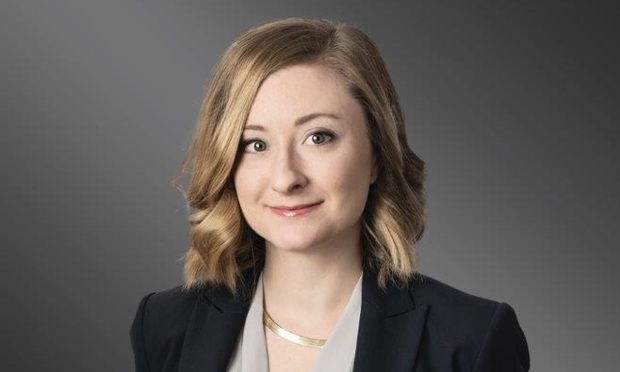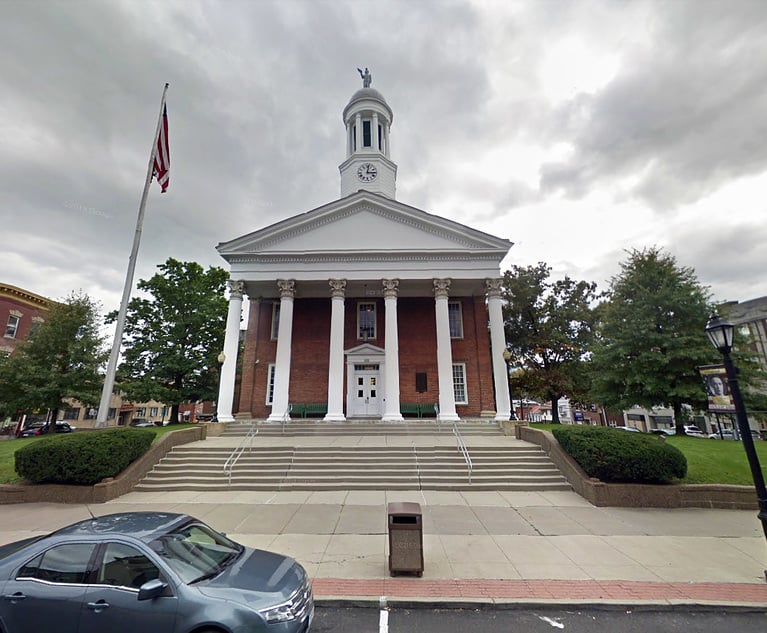Are You Ready? Revisions to Management of Fill Policy Take Effect Jan. 1
The policy supplements existing requirements outlined in Pennsylvania's Solid Waste Management Act municipal and residual waste regulations and provides guidance on the management of clean fill and regulated fill in the commonwealth.
December 19, 2019 at 12:02 PM
9 minute read
 Candee Wilde, Greenberg Traurig
Candee Wilde, Greenberg Traurig
As the economy strengthens, development and infrastructure projects continue on an upward trend in the region. Whether the project involves remediating a brownfield site or performing utility work in a public right-of-way, the management of fill material such as soil, rock or stone is often a primary consideration impacting the project's budget. In the commonwealth of Pennsylvania, the Pennsylvania Department of Environmental Protection (the DEP or department) generally regulates the management of fill material, however projects involving PCB-containing fill are under the oversight of the U.S. Environmental Protection Agency (EPA). On Nov. 2, the DEP issued a revised management of fill policy (the policy), which makes sweeping changes to the existing policy in effect since Aug. 7, 2010. The policy supplements existing requirements outlined in Pennsylvania's Solid Waste Management Act municipal and residual waste regulations and provides guidance on the management of clean fill and regulated fill in the commonwealth. See 25 Pa. Code Section 271.1 and § 287.1. Many industries, ranging from developers to soil recycling facilities to soil brokers, must get up to speed by Jan. 1, 2020 when the policy takes effect.
What Is the Policy?
At its core, the policy provides comprehensive guidance on fill movement activities within the commonwealth. It is inapplicable to materials reused in the newly defined project area or right-of-way or for mine land reclamation activities. Under the policy, clean fill generally can be used in an unrestricted manner and is permitted to be managed without oversight of the department (although Form FP-001 is required to track the movement of clean fill). By contrast, the use of regulated fill is restricted to placement at nonresidential properties only.
A person managing regulated fill must obtain General Permit WMGR096 in many cases. The new changes to the policy clarify that the permit is required only if regulated fill is used outside of a project area or right-of-way of a project area. Further, a permit is not required for management of regulated fill entirely at an Act 2 site or when regulated fill is moved from one Act 2 site to another Act 2 site. Notwithstanding these exemptions, the management of fill within a site may still be limited to some extent depending on what is appropriately characterized as the "project area" or the "Act 2 site."
How Has the Policy Changed?
The new policy more than triples the number of defined terms and makes numerous changes to existing terms. Fill is newly defined to include clean fill, regulated fill and historic fill. The definition of clean fill was revised to mean as "uncontaminated, nonwatery-soluble, nondecomposable, inert solid material used to level an area or bring an area to grade." The term makes reference to the definition of uncontaminated or uncontaminated material, which has been expanded to mean fill unaffected by a release of a regulated substance or fill affected by a release of a regulated substance but within the new clean fill concentration limits (CFCLs). Regulated fill now means fill material "that has been affected by a release of a regulated substance and is not 'uncontaminated material.'" Although the concept was previously included in the policy, the definitions of clean rill, regulated fill and uncontaminated or uncontaminated material now all repeat the prohibition on blended, mixed or treated fill that would otherwise fail to meet the applicable numeric concentration limits if not blended, mixed or treated.
Under this policy, the department endorses a hands-off approach allowing the fill market to function largely without restriction or Department oversight, while also providing detailed—and more burdensome—guidance on performing appropriate due diligence. The policy establishes various protocols for performing a fill determination, determining whether fill can be placed in donor location, and sampling waste piles and in situ material. A fill determination must be completed prior to moving fill to a receiving site. As part of this process, fill must first be determined eligible for management as clean fill or regulated fill under the policy—e.g. it is not excluded or under the jurisdiction of another agency. Then, environmental due diligence is required to determine whether the material has been affected by a release. Due diligence is performed on a case-by-case basis, and not every instance will require analytical testing. Except for historic fill, pre-testing is not required unless a property history review and visual inspection suggest a release of a regulated substance has impacted the fill. Historic fill can be managed as clean fill if the testing results are within the CFCL. There is some concern that the more onerous due diligence requirements set forth in this policy will complicate even the smallest projects, requiring the need of environmental professionals to guide homeowners and private citizens through the process.
In the event testing is required, the policy sets forth detailed requirements for analytical testing in Appendix A, including the development of sampling plans, sampling procedures for fill piles and in-situ fill, evaluation of data, and testing methodology. The technical requirements could be cost prohibitive or excessive for certain projects. As one example, the department now allows fill that contains constituents with exceedances of a CFCL or a regulated fill concentration limit (RFCL) not known to be associated with a release from a known source to be used at a receiving site when background demonstrations are performed at the donor site to show that exceedances are the result of background conditions. Equivalent site evaluations must then be performed to ensure the receiving site conditions also contain the same substances in higher concentrations. At a minimum, 40 samples are required before establishing that the fill can be used at the receiving site. For certain naturally occurring constituents that by nature exceed background levels, this level of effort may be heavy handed. Although other states like New Jersey set default background standards, the department has yet to evaluate whether similar standards can be used as a default where testing at receiving sites would otherwise be too onerous.
What Are the New Numeric Standards?
The prior version of the policy established static numeric standards for clean fill based on the residential cleanup standards under the Land Recycling and Environmental Remediation Standards Act (Act 2) which were in place at the effective date of the prior policy. This new policy takes a risk-based approach to regulating the management of fill. It directly incorporates the statewide health standards (SHSs) set forth in the Act 2 and the applicable regulations as the basis for determining newly defined CFCLs and RFCLs. These SHSs are updated every three years based on the most up-to-date scientific information.
Those impacted by this policy must stay informed of changes to the CFCLs and RFCLs as updates are made to the Act 2 SHSs because the changes could significantly impact the bottom line of a project. The current standards are conservative and limit what types of fill can be characterized as clean fill. For example, the standard for benzo(a)pyrene—prevalent in many fill materials due to historic burning of coal and exhaust or presence of asphalt—is now lower than background in many areas. Vanadium also has new standards below background. These standards effectively result in the potential outcome that no fill may be considered clean fill in Pennsylvania. As a result, companies with material that previously could be managed as clean fill in Pennsylvania may have to pay more per cubic yard to manage the fill due to the lack of placement options.
What Is EPA's role?
There has been a shift in the implementation of the EPA's Toxic Substances Control Act (TSCA) program in Pennsylvania associated with the management of fill in recent years. Although the new policy provides some guidance on fill containing Polychlorinated Biphenyls (PCBs), the Department is clear that PCBs must be managed in coordination with state programs and TSCA, which the DEP has no delegated authority to implement. Under the policy, the DEP requires that EPA provide written approval before fill containing a total PCB concentration exceeding 2 parts per million (ppm) can be managed under state oversight, even though the CFCLs and RFCLs for some aroclors exceed 2 ppm. Further, any fill suspected of being TSCA-subject due to a release of PCBs requires EPA approval prior to performing a fill determination. No program currently exists between the DEP and EPA to facilitate these approvals. It remains to be seen how smoothly and quickly the process will be with both agencies having some level of involvement.
What's Next?
The regulated community will undoubtedly need time to digest the changes within this policy in order to avoid delays in projects or costly arrangements for the placement of fill at more expensive locations or facilities. In addition, the community will also need to prepare for future changes in the numeric standards or other requirements. The revisions to this policy precede an anticipated overhaul of General Permit WMGR096, which is the permit required by the policy for the beneficial reuse of regulated fill. Like the policy, the most recent draft revisions of the general permit were harshly criticized as requiring onerous conditions relating to application, reporting, due diligence, testing and other requirements. The DEP intends on allowing another 60-day notice and comment period prior to finalizing the changes to the permit.
Candee Wilde practices in the environmental group of Greenberg Traurig. She resides in the Philadelphia office. As part of her practice, she advises developers in the purchase and remediation of brownfields properties and businesses operating in the fill industry. Contact her at [email protected].
This content has been archived. It is available through our partners, LexisNexis® and Bloomberg Law.
To view this content, please continue to their sites.
Not a Lexis Subscriber?
Subscribe Now
Not a Bloomberg Law Subscriber?
Subscribe Now
NOT FOR REPRINT
© 2025 ALM Global, LLC, All Rights Reserved. Request academic re-use from www.copyright.com. All other uses, submit a request to [email protected]. For more information visit Asset & Logo Licensing.
You Might Like
View All
Energy Lawyers Field Client Questions as Trump Issues Executive Orders on Industry Funding, Oversight
6 minute read
Superior Court Directs Western Pa. Judge to Recuse From Case Over Business Ties to Defendant
3 minute read
Judge Rejects Exxon Mobil's Challenge to $725M Benzene Verdict, Adds $91M in Delay Damages
3 minute read
Exxon Mobil Claims Juror's Online Posts Show Bias Behind $725M Benzene Verdict
4 minute readLaw Firms Mentioned
Trending Stories
Who Got The Work
J. Brugh Lower of Gibbons has entered an appearance for industrial equipment supplier Devco Corporation in a pending trademark infringement lawsuit. The suit, accusing the defendant of selling knock-off Graco products, was filed Dec. 18 in New Jersey District Court by Rivkin Radler on behalf of Graco Inc. and Graco Minnesota. The case, assigned to U.S. District Judge Zahid N. Quraishi, is 3:24-cv-11294, Graco Inc. et al v. Devco Corporation.
Who Got The Work
Rebecca Maller-Stein and Kent A. Yalowitz of Arnold & Porter Kaye Scholer have entered their appearances for Hanaco Venture Capital and its executives, Lior Prosor and David Frankel, in a pending securities lawsuit. The action, filed on Dec. 24 in New York Southern District Court by Zell, Aron & Co. on behalf of Goldeneye Advisors, accuses the defendants of negligently and fraudulently managing the plaintiff's $1 million investment. The case, assigned to U.S. District Judge Vernon S. Broderick, is 1:24-cv-09918, Goldeneye Advisors, LLC v. Hanaco Venture Capital, Ltd. et al.
Who Got The Work
Attorneys from A&O Shearman has stepped in as defense counsel for Toronto-Dominion Bank and other defendants in a pending securities class action. The suit, filed Dec. 11 in New York Southern District Court by Bleichmar Fonti & Auld, accuses the defendants of concealing the bank's 'pervasive' deficiencies in regards to its compliance with the Bank Secrecy Act and the quality of its anti-money laundering controls. The case, assigned to U.S. District Judge Arun Subramanian, is 1:24-cv-09445, Gonzalez v. The Toronto-Dominion Bank et al.
Who Got The Work
Crown Castle International, a Pennsylvania company providing shared communications infrastructure, has turned to Luke D. Wolf of Gordon Rees Scully Mansukhani to fend off a pending breach-of-contract lawsuit. The court action, filed Nov. 25 in Michigan Eastern District Court by Hooper Hathaway PC on behalf of The Town Residences LLC, accuses Crown Castle of failing to transfer approximately $30,000 in utility payments from T-Mobile in breach of a roof-top lease and assignment agreement. The case, assigned to U.S. District Judge Susan K. Declercq, is 2:24-cv-13131, The Town Residences LLC v. T-Mobile US, Inc. et al.
Who Got The Work
Wilfred P. Coronato and Daniel M. Schwartz of McCarter & English have stepped in as defense counsel to Electrolux Home Products Inc. in a pending product liability lawsuit. The court action, filed Nov. 26 in New York Eastern District Court by Poulos Lopiccolo PC and Nagel Rice LLP on behalf of David Stern, alleges that the defendant's refrigerators’ drawers and shelving repeatedly break and fall apart within months after purchase. The case, assigned to U.S. District Judge Joan M. Azrack, is 2:24-cv-08204, Stern v. Electrolux Home Products, Inc.
Featured Firms
Law Offices of Gary Martin Hays & Associates, P.C.
(470) 294-1674
Law Offices of Mark E. Salomone
(857) 444-6468
Smith & Hassler
(713) 739-1250





